With the most recent CPI data coming in at 8.5% over the prior year, there’s been a lot of talk online about inflation and it’s impact on your finances. Unfortunately, one of the most common arguments made about inflation with respect to your income isn’t exactly correct. The argument goes as such:
If inflation is 8.5% and your employer gives you a raise of less than 8.5%, then you are worse off in purchasing power terms than last year.
On its face this argument makes logic sense. If prices increase by 8.5%, then your pay has to go up by 8.5% in order to be the same off, right? Well, not exactly. There are two major problems with this argument.
First, this argument assumes that your inflation rate is the same as the inflation rate calculated in the CPI index. But, we know that this probably isn’t true. Since everyone consumes different things in different quantities, we all have our own personal inflation rates. For example, since I don’t own a car, higher gasoline prices impact me less than someone who commutes to work everyday. But let’s put this argument aside for now and assume that your personal rate of inflation matches the CPI data.
Second, the logic above assumes that your pay is identical to your spending. If your pay is above your rate of spending (i.e. you are a saver), then you can get by with a raise less than inflation and be the same off. Let me illustrate with an example.
Let’s assume that you are being paid $100,000 a year after taxes and you spend $50,000 of it. Well, if inflation hits 10% over the next year, your basket of goods will now cost $55,000 (i.e. $5,000 more) to purchase. How much does your $100,000 salary have to go up to offset this? 10%? Nope. It only takes 5% (i.e. $5,000) for you to break even. This is half the rate of inflation.
This simple example demonstrates why a X% increase in inflation does not need to be met with an X% increase in pay if you are a saver. In fact, using the example above, any raise greater than 5% makes you better off in a world with 10% inflation. Why? Because the first 5% is required to keep your consumption constant (i.e. the additional $5,000) and anything above that is pure upside.
Ultimately, what matters when it comes to inflation and your raise is your spending relative to your income, a.k.a. your savings rate. If your income after-taxes perfectly matches your spending (i.e. you don’t save any money), then, yes, you would need an inflation-sized raise to be the same off over time. However, if you are a saver, then your income can rise by some amount less than inflation and you would be unaffected by it.
In particular, you can solve for the exact amount of a raise you would need to offset inflation with this simple formula:
Raise Needed (%) = Inflation (%) – [Savings Rate (%) * Inflation (%)]
In the example above, inflation was 10% and your savings rate was 50% ($50,000/$100,000). Therefore:
Raise Needed (%) = 10% – (50% * 10%)
Raise Needed (%) = 10% – 5%
Raise Needed (%) = 5%
This formula also demonstrates that if your savings rate is 0%, then you require a raise equal to inflation.
More importantly, this formula leads us to an unfortunate conclusion—inflation has a larger impact on those with lower savings rates. And since we know empirically that those with lower savings rates are typically those with lower incomes (see ch.3 of Just Keep Buying), this means that inflation is disproportionally harmful to the poor.
But what makes this result even worse is that the poor tend to not own any income-producing assets either. These income-producing assets (such as stocks and real estate) tend to rise during periods of high inflation, but those with little wealth don’t see these benefits. Therefore, not only are the poor affected by inflation through their incomes, but also through their lack of wealth. It’s a double whammy that those with higher incomes and higher wealth mostly get to ignore.
So what does this mean for you? If you want to protect your finances against inflation you should:
- Have a higher savings rate
- Own income-producing assets that tend to rise with inflation
By having a higher savings rate, you need less of a rise in income to offset future changes in prices (i.e. you have a bigger buffer against future inflation). And by owning income-producing assets such as stocks, farmland, and real estate, your wealth should keep pace with inflation (to some degree) over the long-run.
Given these conclusions, the person least impacted by inflation would be an extremely frugal investor. While I have been critical of extreme frugality on this blog, when it comes to fighting inflation, these people are unmatched. Why? Because they spend less money on an absolute and relative basis! And because they spend less money, they have to worry less about inflation than those who spend more.
Of course, I am not advocating that you start re-using your dental floss or making your dish soap at home, but if inflation worries you that much, spending less is your best option, especially in the short run. In the long run, I recommend growing your income and buying income-producing assets that will rise with prices over time.
Until next week, thank you for reading!
If you liked this post, consider signing up for my newsletter.
This is post 290. Any code I have related to this post can be found here with the same numbering: https://github.com/nmaggiulli/of-dollars-and-data

